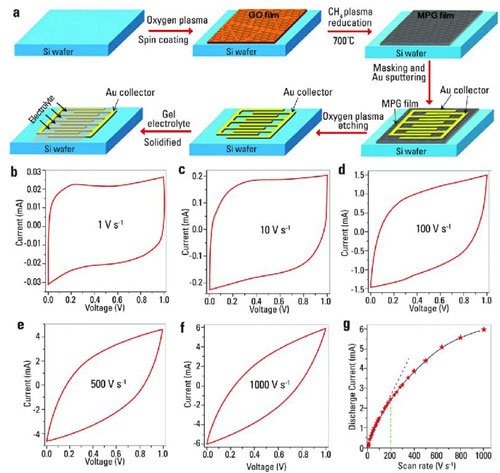| Posted: Aug 12, 2014 |
Graphene-based planar micro-supercapacitors for on-chip energy storage
|
|
(Nanowerk News) The rapid development of miniaturized portable electronic devices, such as micro-electromechanical systems, microrobots and implantable medical devices, has stimulated intense demand for micro-scale power sources. Although miniaturized micro-batteries that store energy by redox reactions provide the most frequently used micro-power source for current portable electronics on chip, their limited lifetime (hundreds or thousands of cycles) and low power density rule out applications that require high power over a short timeframe.
|
|
Micro-supercapacitors (MSCs) with a short ion diffusion distance are newly emerging miniaturized high-power microelectrochemical energy-storage devices that can deliver high power density, fast charge and discharge, and a superior cycling lifetime (millions of cycles). MSCs possess great potential for flexible and on-chip portable and self-powered operation.
|
|
Graphene has been demonstrated to be a very promising candidate for constructing high-performance and flexible MSCs due to its unique structural features and physical properties, e.g., large surface area, high intrinsic areal capacitance and gravimetric capacitance. Graphene-based MSCs can fully utilize the planar geometry and advantageous features of graphene for on-chip energy storage. Planar MSCs that allow electrolyte ions to rapidly interact with all graphene layers in the horizontal direction are superior to conventional sandwich-like stacked devices.
|
 |
| This image is an illustration of the fabrication of all-solid-state interdigital graphene-based MSCs integrated onto a silicon wafer. The CV curves of the graphene-based MSCs at different scan rates from 1 to 1000 V/s. This is a plot of the discharge current as a function of the scan rate. (©Science China Press)
|
|
In a new overview published in the Beijing-based National Science Review ("Recent advances in graphene-based planar micro-supercapacitors for on-chip energy storage"), scientists at the Max Planck Institute for Polymer Research in Mainz, Germany, and at the Shenyang National Laboratory for Materials Science in Shenyang, China present the latest advances in on-chip graphene-based planar interdigital MSCs. Co-authors Zhong-Shuai Wu, Xinliang Feng and Hui-Ming Cheng trace the history of the development of supercapacitors; they also review representative graphene-based materials (graphene sheets, graphene quantum dots and graphene hybrids) used to manufacture MSCs, typical microfabrication strategies (photolithography techniques, electrochemical methods, laser writing), electrolytes (aqueous, organic, ionic and gel), and device configurations (symmetric and asymmetric).
|
|
These scientists likewise outline the potential development directions of future graphene-based MSCs.
|
|
"Traditionally, a supercapacitor is composed of two collectors, two electrodes, a separator and an electrolyte, and the cell is assembled into a sandwich-like stacked configuration of a collector/electrode/separator/electrode/collector and is surrounded with sealing and packaging materials," they state in an article titled "Recent advances in graphene-based planar micro-supercapacitors for on-chip energy storage."
|
|
"The electrolyte mostly consists of a conductive liquid mixture of an aqueous or organic solvent that can migrate into and out of the two electrodes during the charge and discharge process," they add. "The two electrodes are mechanically separated by an ion-permeable membrane that serves as a separator between the two electrodes to prevent a short circuit. The metallic collectors electrically connect the electrodes as the input/output terminals of electricity to an outside circuit."
|
|
The first prototype planar MSCs built with a liquid electrolyte on a silicon substrate in 2003 gave way to later optimized construction of all-solid-state and flexible MSCs, and then to the state-of-the-art, carbon-based MSCs.
|
|
Advances have included graphene-based planar interdigital MSCs that were based on methane plasma reduced graphene films micropatterned on arbitrary substrates. "These microdevices allow operation at ultrahigh rates up to 1000 V s-1, three orders of magnitude higher than conventional supercapacitors, highlighting the superiority of the planar device geometry over the classical sandwich-like stack geometry for supercapacitors," they state.
|
|
"Further improvement in the performance of graphene-based MSCs can be achieved through the reasonable optimization of the composition of the active electrode materials, thin-film manufacturing techniques, interfacial integrity of the main components (electrode, separator, electrolyte and substrate) and micro-electrode design, as well as the selection of the electrolytes," the scientists forecast.
|
|
"The current advancement of graphene-based MSCs should address the urgent need for micro-scale energy storage," they add. "Graphene-based MSCs promise ultrahigh energy and power micro-electrochemical energy-storage devices that are able to offer enough energy and satisfy the peak power required for a great number of applications in miniaturized electronic devices."
|

